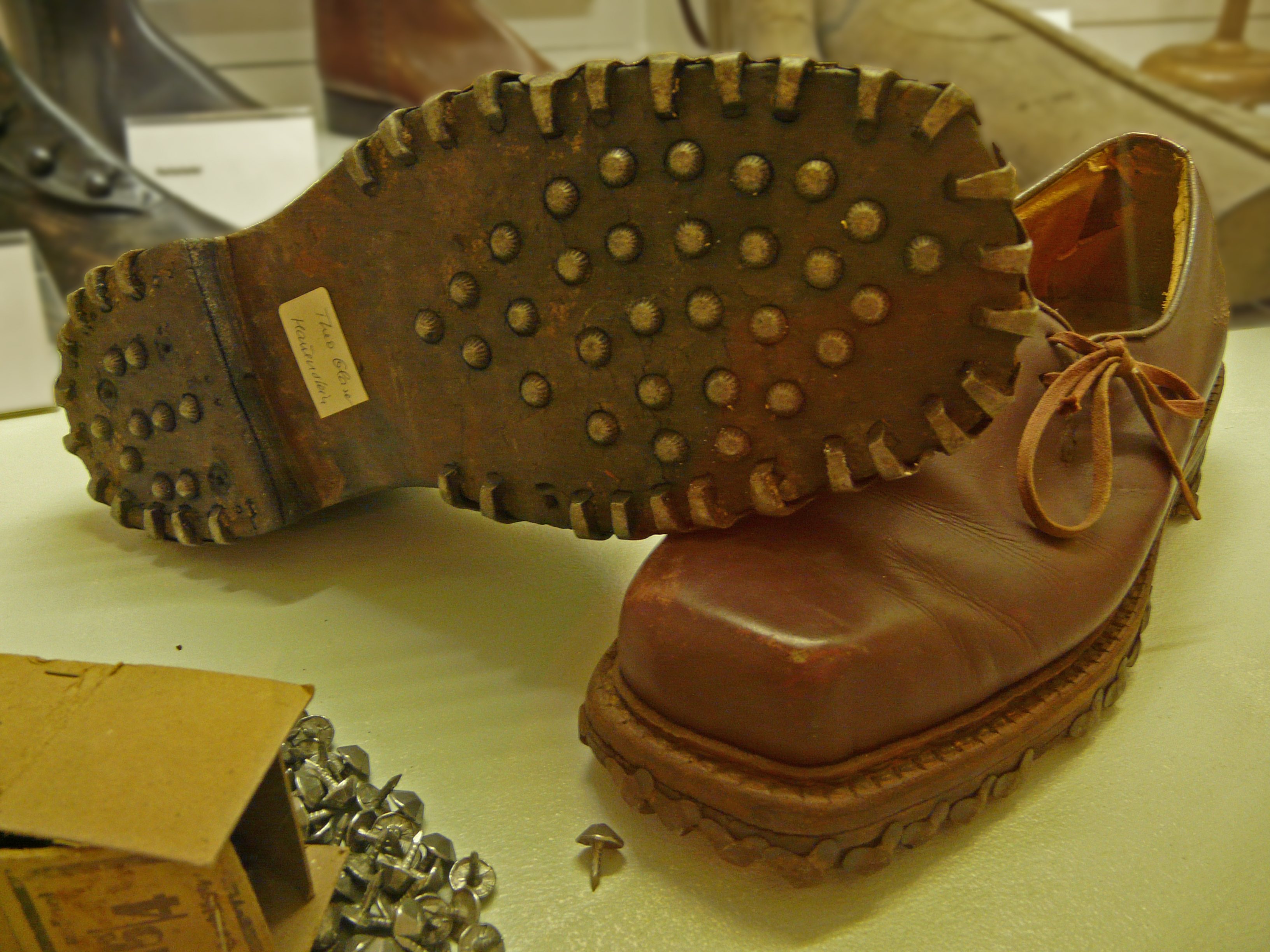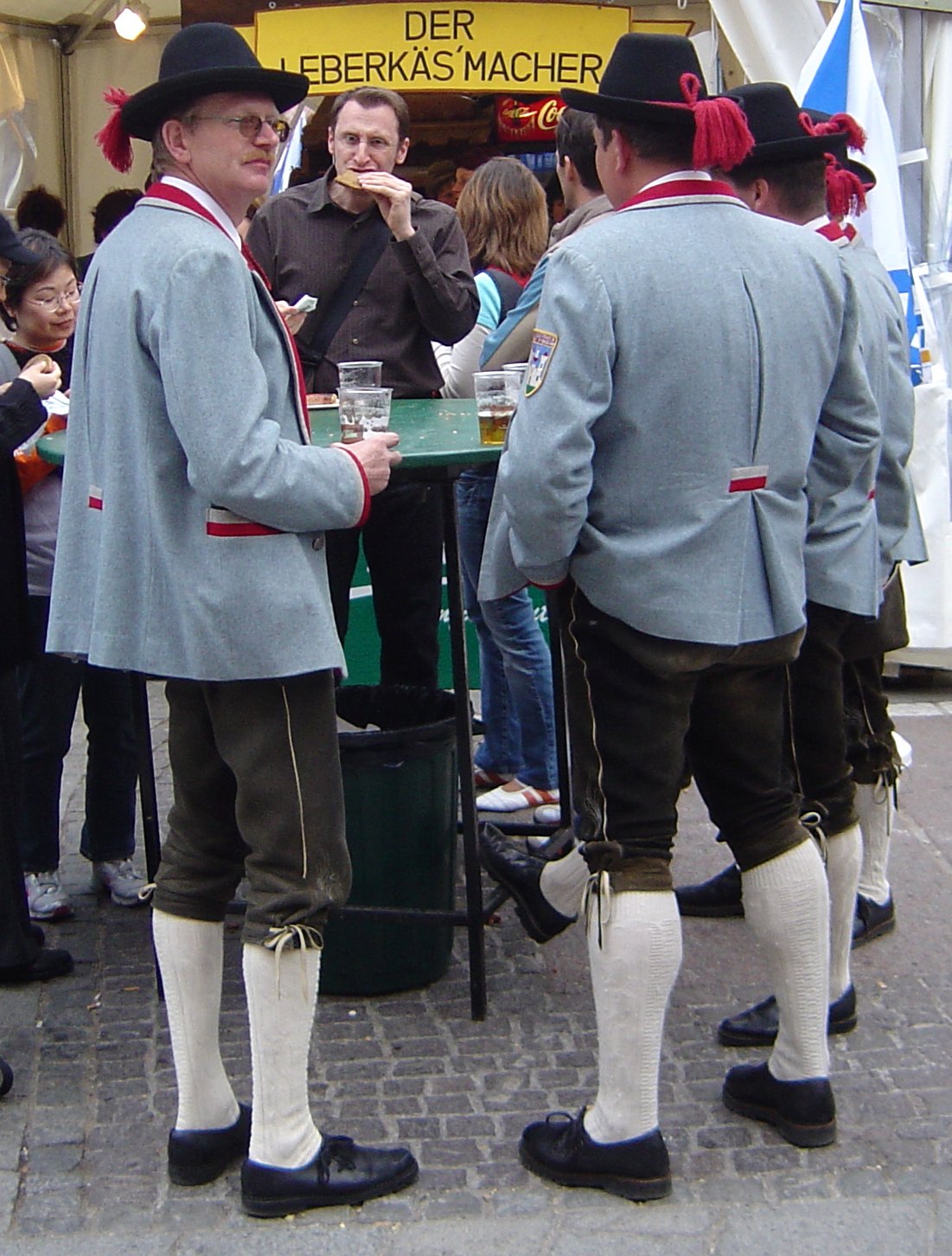|
Haferlschuh
The Haferlschuh () is the traditional Bavarian shoe. It was designed originally as a work shoe for alpine terrain, but it can now be worn in a more general setting. In Bavaria it may also be called a ''Bundschuh''. In Austria, it is known as a ''Schützenschuh.'' According to legend, in 1803 Franz Schratt, an alpine shoemaker from Oberstdorf (located in the Allgäu region of the Bavarian Alps), developed the Haferlschuh inspired by the goat hoof. However, Sternke asserts that the Haferlschuh is much older. With a boatlike front and hobnailed sole, the shoes gave the wearer stability. Since 1900, the Haferlschuh has become a part of many alpine Trachten. Nonetheless, the Haferlschuh is still worn as an everyday shoe, and not just for special occasions like Oktoberfest The Oktoberfest (; bar, Wiesn, Oktobafest) is the world's largest Volksfest, featuring a beer festival and a travelling carnival. It is held annually in Munich, Bavaria, Germany. It is a 16- to 18-day f ... [...More Info...] [...Related Items...] OR: [Wikipedia] [Google] [Baidu] |
Tracht
''Tracht'' () refers to traditional garments in German-speaking countries and regions. Although the word is most often associated with Bavarian, Austrian, South Tyrolian and Trentino garments, including lederhosen and dirndls, many other German-speaking peoples have them, as did the former Danube Swabian populations of Central Europe. Name The word "Tracht" comes from the verb "tragen" (to carry or wear); thus the derived noun "Tracht" means "what is worn". So "Tracht" can refer to the clothes which are worn. The noun also has other uses deriving from the verbal meaning, e.g. a load, a device for carrying a load on the shoulders, or the load of honey carried in by the bees). It also appears within the German idiom "eine Tracht Prügel" (a ''load'' (of) beating or, alternately, "a good beating"). "Tracht" is commonly used to refer the way of dressing associated with a particular people group (''Volkstracht''), social class or occupation (''Arbeitstracht''). Most often it refers ... [...More Info...] [...Related Items...] OR: [Wikipedia] [Google] [Baidu] |
Bavaria
Bavaria ( ; ), officially the Free State of Bavaria (german: Freistaat Bayern, link=no ), is a state in the south-east of Germany. With an area of , Bavaria is the largest German state by land area, comprising roughly a fifth of the total land area of Germany. With over 13 million inhabitants, it is second in population only to North Rhine-Westphalia, but due to its large size its population density is below the German average. Bavaria's main cities are Munich (its capital and largest city and also the third largest city in Germany), Nuremberg, and Augsburg. The history of Bavaria includes its earliest settlement by Iron Age Celtic tribes, followed by the conquests of the Roman Empire in the 1st century BC, when the territory was incorporated into the provinces of Raetia and Noricum. It became the Duchy of Bavaria (a stem duchy) in the 6th century AD following the collapse of the Western Roman Empire. It was later incorporated into the Holy Roman Empire, became an ind ... [...More Info...] [...Related Items...] OR: [Wikipedia] [Google] [Baidu] |
Oberstdorf
Oberstdorf ( Low Alemannic: ''Oberschdorf'') is a municipality and skiing and hiking town in Germany, located in the Allgäu region of the Bavarian Alps. It is the southernmost settlement in Germany and one of its highest towns. At the center of Oberstdorf is a church whose tall spire serves as a landmark for navigating around town. The summits of the Nebelhorn and Fellhorn provide dramatic panoramic views of the alps. The Nebelhorn can be reached with a big cable car. Visitors can ride a unique diagonal elevator to the top of the Heini-Klopfer-Skiflugschanze. Geography Administrative divisions Oberstdorf consists of the village of Oberstdorf (813 metres above sea level, survey point by the Roman Catholic church) and five other villages: * ''Kornau'' , 915 m. In the vicinity is the Söllereckbahn and the Chapel of St. Fabian and St. Sebastian which is rich in art treasures. * In ''Reichenbach'' (population: 226) is the 450-year-old Chapel of St. James and ... [...More Info...] [...Related Items...] OR: [Wikipedia] [Google] [Baidu] |
Allgäu
The Allgäu (Standard German: , also Allgovia) is a region in Swabia in southern Germany. It covers the south of Bavarian Swabia, southeastern Baden-Württemberg, and parts of Austria. The region stretches from the pre-alpine lands up to the Alps. The main rivers flowing through the Allgäu are the Lech and Iller. Allgäu is not an administrative unit. The alpine regions of the Allgäu rise over 2,000 metres in elevation and are popular for winter skiing. The Allgovian area is notable for its beautiful landscapes and is popular for vacations and therapeutic stays.Its scenic countryside can be seen in Asmus, C. and Bufe, S. "Dampflokomotiven im Allgau" (1977, Hermann Merker). It is well known in Germany for its farm produce, especially dairy products including ''Hirtenkäse'' ("herdsman's cheese") and Bergkäse ("mountain cheese"). Besides tourism and dairy products, another important economic sector is the building of industrial equipment and machines. Fendt tractors, develop ... [...More Info...] [...Related Items...] OR: [Wikipedia] [Google] [Baidu] |
Bavarian Alps
The Bavarian Alps (german: Bayerische Alpen) is a collective name for several mountain ranges of the Northern Limestone Alps within the German state of Bavaria. Geography The term in its wider sense refers to that part of the Eastern Alps that lies on Bavarian state territory. However, it is traditionally understood that the Bavarian Alps are only those ranges between the rivers Lech and Saalach ('' Altbayern''). In this narrower sense, the Allgäu Alps in Swabia, which have only been part of Bavaria in more recent times, and the Berchtesgaden Alps in the east are not considered part of the Bavarian Alps. The term is frequently used, but does not correspond to the common classification of the Eastern Alps (AVE) developed by the German, Austrian and South Tyrol Alpine Clubs. It should not be confused with the term Bavarian Prealps either. The latter only covers the Bavarian section of the Prealps between the River Loisach in the west and the River Inn in the east. According t ... [...More Info...] [...Related Items...] OR: [Wikipedia] [Google] [Baidu] |
Hobnailed
In footwear, a hobnail is a short nail with a thick head used to increase the durability of boot soles. Uses Hobnailed boots (in Scotland "tackety boots") are boots with hobnails (nails inserted into the soles of the boots), usually installed in a regular pattern, over the sole. They usually have an iron horseshoe-shaped insert, called a heel iron, to strengthen the heel, and an iron toe-piece. They may also have steel toecaps. The hobnails project below the sole and provide traction on soft or rocky terrain and snow, but they tend to slide on smooth, hard surfaces. They have been used since antiquity for inexpensive durable footwear, often by workmen and the military. Examples include the '' caligae'' of the Roman military, and the trench boots of World War I. Important design work for the modern hobnailed boot was done during World War I, e.g. the " Pershing boot" in the United States. Problems experienced in designing WWI US Army boots were: *Tearing at the backstay: so ... [...More Info...] [...Related Items...] OR: [Wikipedia] [Google] [Baidu] |
Oktoberfest
The Oktoberfest (; bar, Wiesn, Oktobafest) is the world's largest Volksfest, featuring a beer festival and a travelling carnival. It is held annually in Munich, Bavaria, Germany. It is a 16- to 18-day folk festival running from mid- or late-September to around the first Sunday in October, with more than six million international and national visitors attending the event. Locally, it is called , after the colloquial name for the fairgrounds, Theresienwiese. The Oktoberfest is an important part of Bavarian culture, having been held since the year 1810. Other cities across the world also hold Oktoberfest celebrations that are modeled after the original Munich event. During the event, large quantities of Oktoberfest Beer are consumed. For example, during the 16-day festival in 2014, were served, making it the year where the most beer was consumed at the Oktoberfest. Visitors also enjoy numerous attractions, such as amusement rides, sidestalls, and games. There is also a w ... [...More Info...] [...Related Items...] OR: [Wikipedia] [Google] [Baidu] |
Folk Footwear
Folk or Folks may refer to: Sociology *Nation *People * Folklore ** Folk art ** Folk dance ** Folk hero ** Folk music *** Folk metal *** Folk punk *** Folk rock ** Folk religion * Folk taxonomy Arts, entertainment, and media * Folk Plus or Folk +, an Albanian folk music channel * Folks (band), a Japanese band * ''Folks!'', a 1992 American film People with the name * Bill Folk (born 1927), Canadian ice hockey player * Chad Folk (born 1972), Canadian football player * Elizabeth Folk (c. 16th century), British martyr; one of the Colchester Martyrs * Eugene R. Folk (1924–2003), American ophthalmologist * Joseph W. Folk (1869–1923), American lawyer, reformer, and politician * Kevin Folk (born 1980), Canadian curler * Nick Folk (born 1984), American football player * Rick Folk (born 1950), Canadian curler * Robert Folk (born 1949), American film composer Other uses * Folk classification, a type of classification in geology * Folks Nation, an alliance of American street gangs ... [...More Info...] [...Related Items...] OR: [Wikipedia] [Google] [Baidu] |





